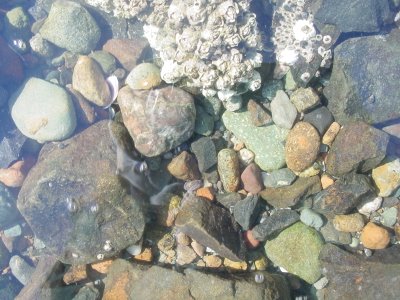

I walked along this beach while George was loading up the canoe. It was a good clamming beach - little puffs of sand around an entrance hole were dotted all over the beach.
The photo of the rocks was an underwater area, with rocks covered in barnacles. A tidal pool is a fascinating place - like peeking into another world.When the tide is out along Puget Sound, the intertidal zone is revealed. Each tide pool holds a pocket of special plants and animals adapted to daily changes in temperature, moisture, oxygen, food sources, and predation.
The tides on Puget Sound rise and fall twice a day, generally including two unequal high tides and two unequal low tides. In Puget Sound, the tide rushes through narrow channels and around islands creating rapids and eddies like a whitewater river. It is important for boaters and beach explorers to know what the tide is doing. Some waters are not navigable at low tide and some beaches may also be hazardous.
We saw a harbor seal poke his head up at us as we paddled along here. He looked at us only one time, his curiosity satisfied. We've had as many as 12 of them at a time circle our canoe, and sniff out information about us. They'll approach within about 40 feet before they dart away.
Mudflats here are some of the most productive habitats in the world, providing acres of crustaceans and invertebrates - prime snacks for shorebirds, such as the Black-bellied Plovers. They can be seen feeding on mud flats in the winter. The Black-bellied Plover uses a short strong bill to crack and eat small mollusks and insects on the surface of the beach. It may also probe deeper into sediments for worms and small bivalves.
We saw Kingfisher, Sandpiper, Buffelhead, Goldeneyes, and Lesser Yellowlegs. The latter nimbly wade through shallow waters, sweeping the top two inches of water for tiny fish and tadpoles. Along the immediate shoreline the water felt warmer, and little tadpoles were burrowing into the sand.
Migrating shorebirds are usually seen resting and feeding on Puget Sound beaches. Several large flocks of birds were coming in for landings in the Nisqually Delta, north of Olympia. We were too far away to identify them, but there were hundreds of them coming north....just a very vibrant, transitional stage in our little area of the world.